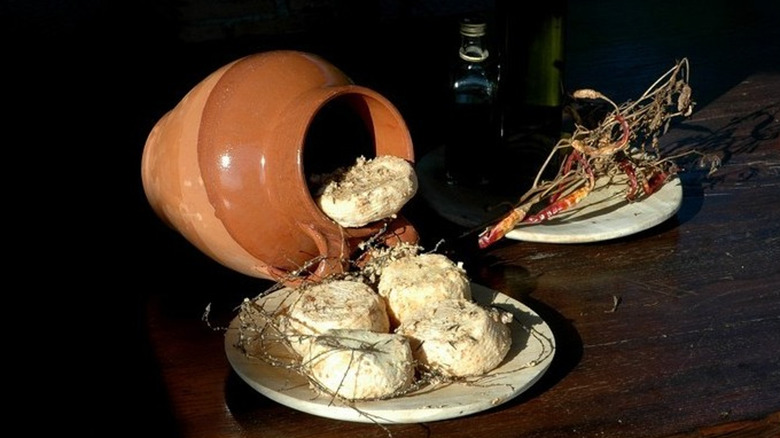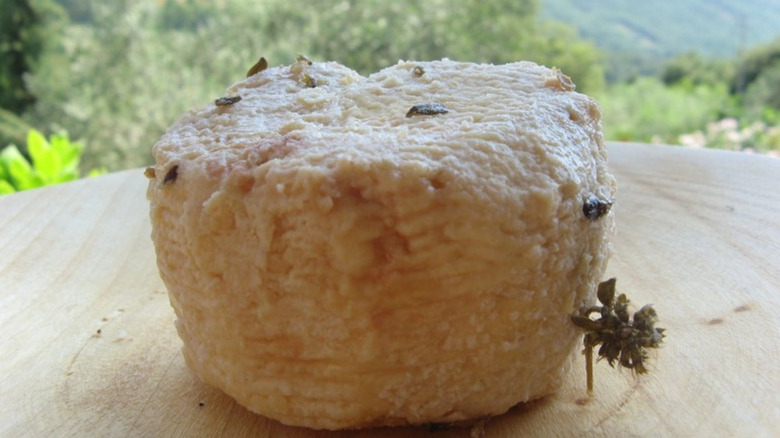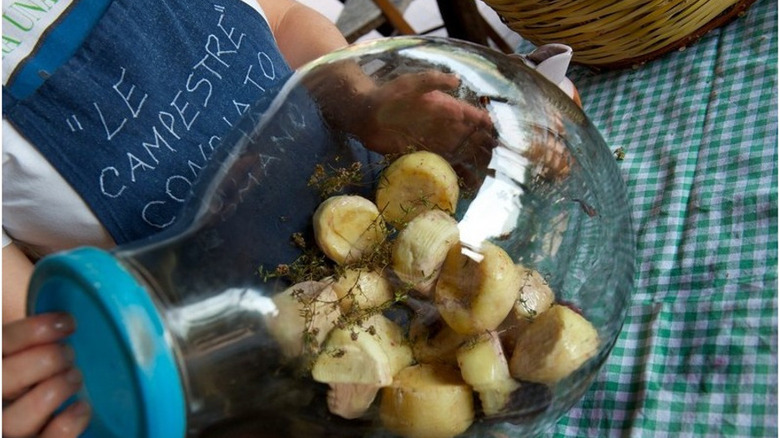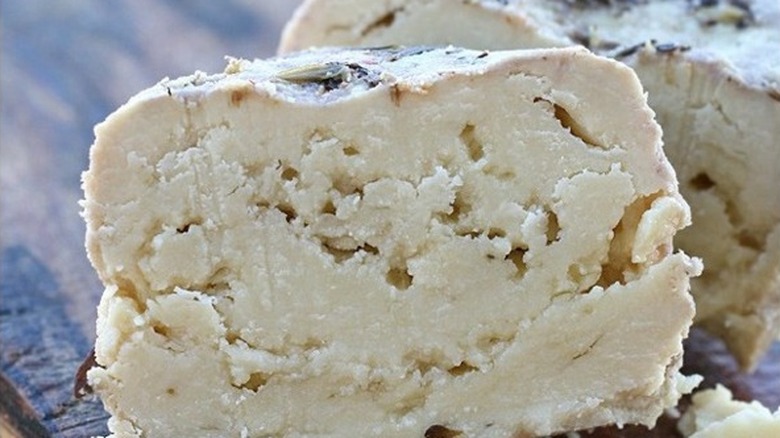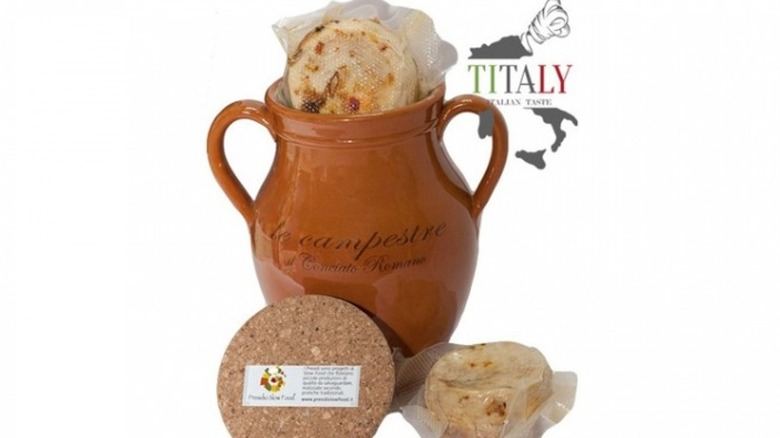Conciato Romano: The Ancient Roman Cheese With A Vinegary Twist
Cheesemaking is an ancient practice dating back roughly 9,000 years. Some speculate that cheese was an accidental discovery, created when milk was stored in a sheep's stomach, which provided the rennet needed to curdle the milk and preserve it as cheese. Regardless of how it was first made, evidence points to the Mediterranean as its birthplace, where it was eaten by ancient Sumerians, Egyptians, and in other countries that border the sea.
While the Egyptians didn't exactly leave a recipe for cheese in their hieroglyphs, we do have the Romans to thank for their assiduous recordkeeping that gives us the oldest written records of a specific kind of cheese, making it the oldest known variety. Though the artifacts that gave us what we know of the cheese may have been discovered in Rome, that's not actually where Conciato Romano was made. Conciato Romano is distinctive, notable for its history, unusual method of production, powerful flavor and aroma, and tiny footprint among cheesemakers.
The history of Conciato Romano
Well before the country of Italy was known as such, people made cheese and wine, as well as fought over territorial borders. Conciato Romano, though it's named, in part, for Rome, dates back to the Samnite people who inhabited south-central Italy. They fiercely resisted the Roman empire for hundreds of years over the course of three distinct wars and even well beyond.
We know about Conciato Romano because it's mentioned in the writings of Pliny, Martial, and Cicero as being an important product of the province of Caserta in the region of Campania, situated between Naples and Rome. Some historians believe the methods of producing and aging the cheese date back to ancient times, perhaps even to the emergence of agro-pastoral civilization. Since the Samnites didn't leave much in the way of written records, we may not know exactly how old this cheese is but we can conclude it has survived much history.
How is Conciato Romano made?
Making Conciato Romano is quite the process — one that results in a cheese distinctive enough that researchers who studied Conciato Romano were able to isolate and identify 76 distinct volatile compounds that evolve as the cheese ages.
Conciato Romano is typically made of sheep's milk, though cow and goat milk may be blended in as well, and it's coagulated with goat rennet. The fresh cheese is hand-pressed into fuscella molds, then dried and ripened the first time. The cheese is later washed with the water used to cook a traditional pasta known as pettole, then tanned with a mixture of oil, wine or wine vinegar, chili pepper, and wild thyme. The name "Conciato" derives from the Italian "cunzato" or "concia" for tanning, a reference to the method of preparing the cheese with oil and vinegar for its second aging.
The seasoned and tanned cheese is placed in clay amphorae or in glass containers to age for a further six months to two years. The amphorae are stored in the dark and moved every 10 days to make sure the cheese inside ripens evenly. When the amphorae are eventually opened, the cheese is intensely aromatic and tangy, stronger than most cheese we may be accustomed to.
Conciato Romano is typically served in small amounts
Because Conciato Romano is so robust in aroma and flavor, it's typically served in tiny amounts, much as one would serve a truffle. It's something rare, precious, and with the potential to overwhelm other flavors with its vinegary profile.
The powerful cheese can adorn a simple pizza, or it can complement a complex pasta dish. Blogger Karen Phillips describes enjoying it with baked pears in a local sparkling wine and a little sugar — the Conciato Romano is cut into small pieces and served on the side (via Andiamo Trips). Chef Franco Pepe uses Conciato Romano to adorn his Mastunicola pizza, which also features preserved figs from Puglia, lard from black pigs native to Caserta, and oregano from Matese, notes Luxeat.
Maria Rosario Stellato, chef and owner of the Caserta restaurant Animamia, which means "my soul," serves Conciato Romano in a number of ways. This includes a burnt wheat ravioli, fragrant with garlic and chili peppers, served atop puréed pumpkin. She also features the cheese on her cheese sampler, pairing the aromatic Conciato Romano with dark chocolate, per La Cucina Italiana.
Where can you buy Conciato Romano?
Here's the tricky part. Although Conciato Romano is a food that is made by the Slow Food Presidium, an organization that preserves traditional methods and foods, there are just two producers listed. One is Le Curti, with artisanal cheeses made by Carmine Bonacci; however, it seems to have little online presence and availability.
The second producer is better known and credited with reinvigorating interest in the ancient Conciato Romano. Agriturismo Le Campestre is a small but passionate hotel, restaurant, and producer of cheese. Liliana Lombardi, along with her son Manuel, makes Conciato Romano by hand. If a visit to the charming Agriturismo isn't in your future, online retailer Titaly sells the cheese, available in 200-gram portions and also in a small clay amphora, which allows you to continue aging the cheese after your purchase. The amphora set comes with two 200-gram blocks of cheese, olive oil, wine vinegar, and herbs that traditionally flavor Conciato Romano.
Though the production of Conciato Romano is tiny, word is on the verge of getting out about the ancient cheese. In 2022, an episode of Netflix's Chef's Table Pizza featured chef Franco Pepe and originally had footage of Pepe's visit to Le Campestre, including a conversation with Manuel Lombardi. According to Fine Dining Lovers, it, unfortunately, didn't make the final cut for the show.
